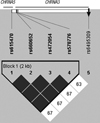1. Rabe KF, Hurd S, Anzueto A, Barnes PJ, Buist SA, Calverley P, Fukuchi Y, Jenkins C, Rodriguez-Roisin R, van Weel C, et al. Global strategy for the diagnosis, management, and prevention of chronic obstructive pulmonary disease: GOLD executive summary. Am J Respir Crit Care Med. 2007. 176:532–555.
2. Mannino DM, Buist AS. Global burden of COPD: risk factors, prevalence, and future trends. Lancet. 2007. 370:765–773.
3. Groneberg DA, Chung KF. Models of chronic obstructive pulmonary disease. Respir Res. 2004. 5:18.
4. Løkke A, Lange P, Scharling H, Fabricius P, Vestbo J. Developing COPD: a 25 year follow up study of the general population. Thorax. 2006. 61:935–939.
5. Sampsonas F, Karkoulias K, Kaparianos A, Spiropoulos K. Genetics of chronic obstructive pulmonary disease, beyond α1-antitrypsin deficiency. Curr Med Chem. 2006. 13:2857–2873.
6. Cha SI, Kang HG, Choi JE, Kim MJ, Park J, Lee WK, Kim CH, Jung TH, Park JY. SERPINE2 polymorphisms and chronic obstructive pulmonary disease. J Korean Med Sci. 2009. 24:1119–1125.
7. Pillai SG, Ge D, Zhu G, Kong X, Shianna KV, Need AC, Feng S, Hersh CP, Bakke P, Gulsvik A, et al. A genome-wide association study in chronic obstructive pulmonary disease (COPD): identification of two major susceptibility loci. PLoS Genet. 2009. 5:e1000421.
8. Ioannidis JP, Thomas G, Daly MJ. Validating, augmenting and refining genome-wide association signals. Nat Rev Genet. 2009. 10:318–329.
9. Frazer KA, Murray SS, Schork NJ, Topol EJ. Human genetic variation and its contribution to complex traits. Nat Rev Genet. 2009. 10:241–251.
10. Manolio TA, Collins FS, Cox NJ, Goldstein DB, Hindorff LA, Hunter DJ, McCarthy MI, Ramos EM, Cardon LR, Chakravarti A, et al. Finding the missing heritability of complex disease. Nature. 2009. 461:747–753.
11. Hirschhorn JN. Genomewide association studies: illuminating biologic pathways. N Engl J Med. 2009. 360:1699–1701.
12. Amos CI, Wu X, Broderick P, Gorlov IP, Gu J, Eisen T, Dong Q, Zhang Q, Gu X, Vijayakrishnan J, et al. Genome-wide association scan of tag SNPs identifies a susceptibility locus for lung cancer at 15q25.1. Nat Genet. 2008. 40:616–622.
13. Hung RJ, McKay JD, Gaborieau V, Boffetta P, Hashibe M, Zaridze D, Mukeria A, Szeszenia-Dabrowska N, Lissowska J, Rudnai P, et al. A susceptibility locus for lung cancer maps to nicotinic acetylcholine receptor subunit genes on 15q25. Nature. 2008. 452:633–637.
14. Pillai SG, Kong X, Edwards LD, Cho MH, Anderson WH, Coxson HO, Lomas DA, Silverman EK. ECLIPSE and ICGN Investigators. Loci identified by genome-wide association studies influence different disease-related phenotypes in chronic obstructive pulmonary disease. Am J Respir Crit Care Med. 2010. 182:1498–1505.
15. Wu C, Hu Z, Yu D, Huang L, Jin G, Liang J, Guo H, Tan W, Zhang M, Qian J, et al. Genetic variants on chromosome 15q25 associated with lung cancer risk in Chinese populations. Cancer Res. 2009. 69:5065–5072.
16. Caulfield MP, Birdsall NJ. International Union of Pharmacology, XVII. Classification of muscarinic acetylcholine receptors. Pharmacol Rev. 1998. 50:279–290.
17. Canning BJ. Reflex regulation of airway smooth muscle tone. J Appl Physiol. 2006. 101:971–985.
18. Rogers DF. Motor control of airway goblet cells and glands. Respir Physiol. 2001. 125:129–144.
19. Gwilt CR, Donnelly LE, Rogers DF. The non-neuronal cholinergic system in the airways: an unappreciated regulatory role in pulmonary inflammation? Pharmacol Ther. 2007. 115:208–222.
20. Carlisle DL, Hopkins TM, Gaither-Davis A, Silhanek MJ, Luketich JD, Christie NA, Siegfried JM. Nicotine signals through muscle-type and neuronal nicotinic acetylcholine receptors in both human bronchial epithelial cells and airway fibroblasts. Respir Res. 2004. 5:27.
21. Wessler I, Kirkpatrick CJ, Racké K. Non-neuronal acetylcholine, a locally acting molecule, widely distributed in biological systems: expression and function in humans. Pharmacol Ther. 1998. 77:59–79.
22. Saccone SF, Hinrichs AL, Saccone NL, Chase GA, Konvicka K, Madden PA, Breslau N, Johnson EO, Hatsukami D, Pomerleau O, et al. Cholinergic nicotinic receptor genes implicated in a nicotine dependence association study targeting 348 candidate genes with 3713 SNPs. Hum Mol Genet. 2007. 16:36–49.
23. Bierut LJ, Stitzel JA, Wang JC, Hinrichs AL, Grucza RA, Xuei X, Saccone NL, Saccone SF, Bertelsen S, Fox L, et al. Variants in nicotinic receptors and risk for nicotine dependence. Am J Psychiatry. 2008. 165:1163–1171.
24. Li MD, Xu Q, Lou XY, Payne TJ, Niu T, Ma JZ. Association and interaction analysis of variants in CHRNA5/CHRNA3/CHRNB4 gene cluster with nicotine dependence in African and European Americans. Am J Med Genet B Neuropsychiatr Genet. 2010. 153B:745–756.
25. Jin G, Bae EY, Yang E, Lee EB, Lee WK, Choi JE, Jeon HS, Yoo SS, Lee SY, Lee J, et al. A functional polymorphism on chromosome 15q25 associated with survival of early stage non-small cell lung cancer. J Thorac Oncol. 2012. 7:808–814.







 PDF
PDF ePub
ePub Citation
Citation Print
Print



 XML Download
XML Download